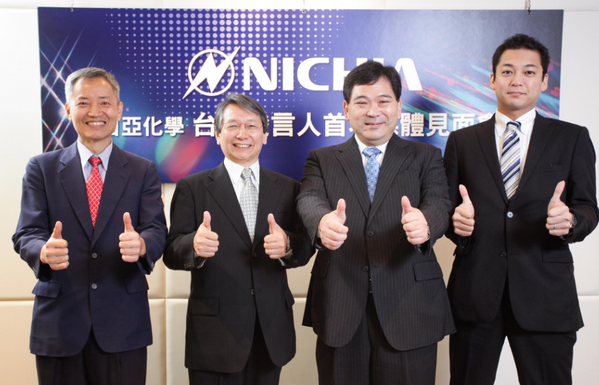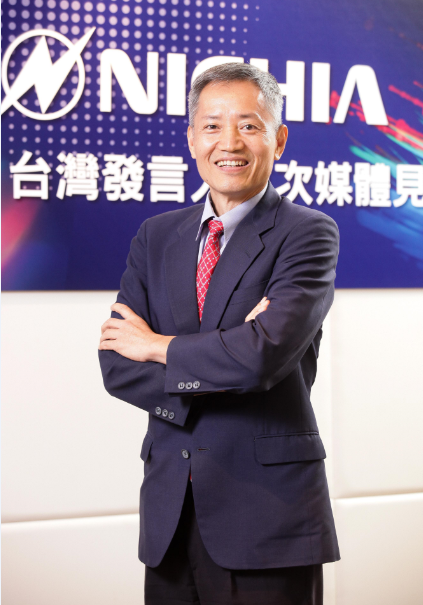Global LED market prices have been disrupted by heavily subsidized Chinese manufacturers, to stay relevant Taiwanese manufacturers need to work on strengthening patent portfolios, said Katsuyuki Akutagawa, Chief Legal and IP Officer Board Director for Nichia at a press conference in Taipei, Taiwan on Thursday.
Taiwanese and Japanese manufacturers need to be very careful in how they respond to Chinese manufacturers’ aggressive pricing strategies, said Akutagawa. LED prices might drop as much as 40% in 2015, due to Chinese manufacturers pricing policies, said Masaki Mukaiyama, special consultant and spokesperson for Nichia Taiwan Corporation. Many clients prefer buying cheap Chinese LEDs that might be dimmer or inferior in quality, but can be compensated with the addition of one or two more LEDs, he added.
 |
|
Left to right: Masaki Mukaiyama, Special Consultant and Spokesperson, Nichia Taiwan, Katsuyuki Akutagawa, Chief Legal & Ip Officer and Board Director, Legal and Intellectual Division, Nichia, Hinori Takagi, General Manager, Intellectual Property Dept., Legal & Intellectual property Division, Nichia, Yuto Iwasa, Assistant Research Scientist, Intellectual Property Dept., Legal and Intellectual Property Division, Nichia. (Photo Credits: Nichia) |
Holding key patents can give manufacturers a competitive edge, as seen in Nichia’s long term investment in GaN blue LED technology from 1993 to 2000, which eventually paid off in 2001. The company incurred losses and took out bank loans to support LED R&D developments from 1993 to 2000. “Nichia for instance might only be earning US $3, but may be willing to spend as much as US $5 in R&D,” said Masaki Mukaiyama, special consultant and spokesperson for Nichia Taiwan Corporation. “How many Taiwanese manufacturers are willing to do that?”
Mukaiyama, a 14-year veteran in the Taiwan LED industry, also recommended Taiwanese LED manufacturers should keep core technology secretive, and grant access to only a few employees to protect itself from losing R&D staff to Chinese headhunters. Chinese manufacturers namely San’an Opto have been aggressively picking Taiwan’s LED engineers from Epistar, Genesis Photonics Inc. (GPI) and others by offering salary as high as five times the rate in Taiwan, said Mukaiyama.
No signs of Nichia reaching settlement with Everlight
To protect its LED patent rights, Nichia has filed lawsuits against other global semiconductor and lighting manufacturers including Toyoda Gosei, Rohm, Cree and Osram. Settlements were reached in these lawsuits, but Nichia is nowhere close to ending its patent dispute with Taiwanese LED manufacturer Everlight. “If relations between Nichia and Everlight were good, we might be able to arrive to a settlement, but we have not seen any signs of arriving to a settlement yet,” said Akutagawa.
The two companies’ patent war started in April 26, 2005, according to LEDinside records. Nichia, which has kept a low-profile during patent lawsuits made a rare move last September, by holding its first press conference in Taipei to address the issue. The company’s recent assignment of its first global spokesperson Mukaiyama to Taiwan out of the 26 countries where it has offices, also shows how much it values the Taiwan market.
 |
|
Masaki Mukaiyama, Special Consultant, Nichia Taiwan, who is based in Taiwan, is the Japanese LED manufacturer's first global spokesperson. |
Nichia has formed partnerships with Taiwanese LED chip maker Epistar, and AOT Group during its 26 years in the Taiwan market. The Japanese manufacturer is very selective when it comes to choosing business partners, and cautious when signing patent license agreements. Most of Nichia’s business partners are long term clients, where a trusting relationship has already been established, explained Mukaiyama.
It can be difficult for Japanese companies to form partnerships with other Asian manufacturers because of different values. “Japanese manufacturers like Nichia tend to take a long term approach and are looking at developments from a 10 year perspective, but many Asian manufacturers want short-term profits and hope to see Return of Investments (ROI) in just three years,” said Mukaiyama.
(Author: Judy Lin, Chief Editor, LEDinside)













